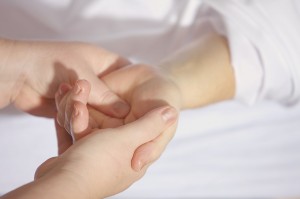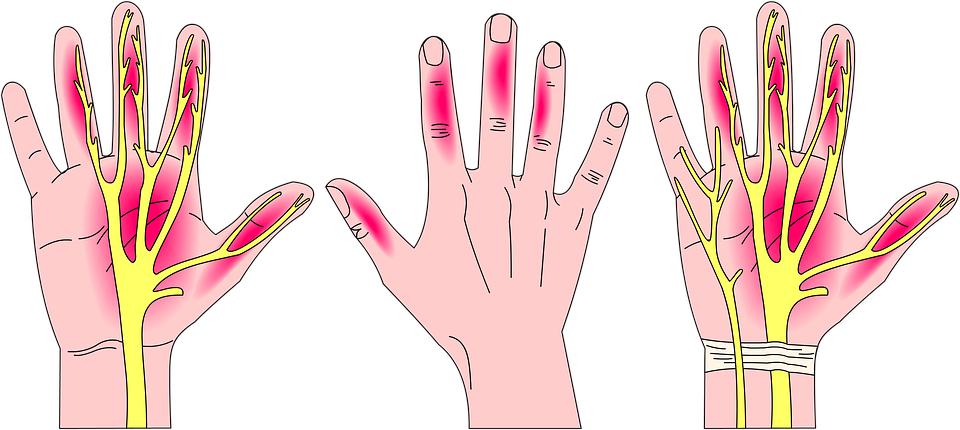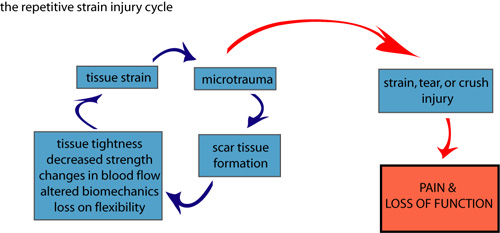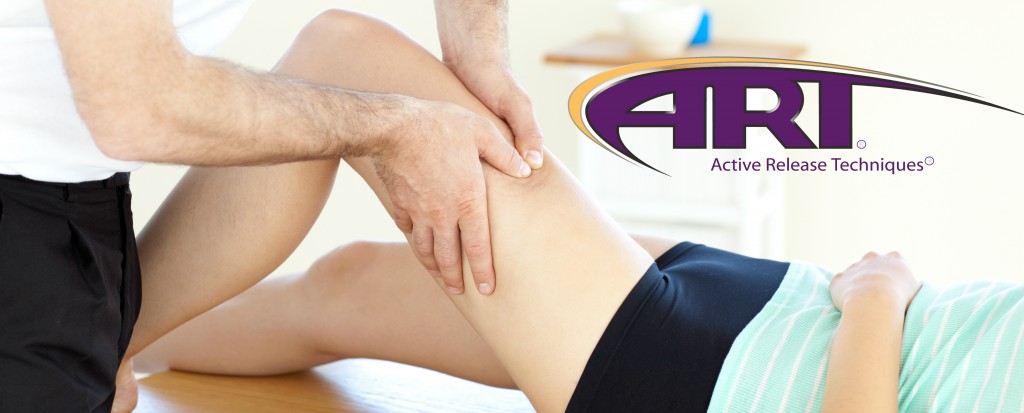Improved Treatment for Carpal Tunnel Syndrome and other common conditions with Active Release Techniques ®
Wrist pain is a common problem! The increase in desk jobs, along with the widespread use of computers in our lives has led to a dramatic rise in the number of muscle and joint conditions involving the wrist and hand. Most complaints are diagnosed as Carpal Tunnel Syndrome, but can also include other conditions such as Ulnar Nerve Syndrome, Wrist Sprain or Strain, Overuse Injury, or a variety of other diagnoses. Not only are wrist and hand problems extremely common, but they can be extremely slow to respond to traditional types of care. In many cases surgery is recommended, although this is far from a perfect solution. All of this leads to a considerable amount of frustration for the wrist or hand pain sufferer, as the problem interferes with work, normal everyday activities, and a good night’s sleep.
Now for the good news, a new treatment technique known as Active Release Techniques® (ART®) is proving to be a very effective method to treat many common wrist and hand problems, including Carpal Tunnel Syndrome. Through ART® treatments, many wrist and hand pain sufferers are now able to finally get a handle on their pain and get back to doing their favorite activities. But before we talk about how ART works so effectively, you first need to understand how the wrist and hand becomes injured in the first place.
How Does Wrist and Hand Pain Occur?
The wrist and hand is a very complex area. Although it is a small region, it consists of a complex system of muscles, nerves, tendons, and joints which work together to enable us to perform what are known as fine motor skills such as typing or buttoning a shirt. In order to accomplish these tasks there are many separate muscles that must properly move and control the many bones of the wrist, and each individual finger. In addition to the intricate systems of muscles in the hand itself, many muscles that move the wrist and hand are actually located in the forearm. These forearm muscles have long tendons that attach to each bone of the wrist, hand, and each individual finger. There are many different muscles in this region, and these muscles are arranged in several layers. As each individual muscle contracts it actually slides on the adjacent muscles. For example, if you were to just move your index finger, only the muscle that controls this finger would shorten, and when it does, it would slide against the other muscles around it. Under normal circumstances this muscle arrangement works very effectively and allows us to accomplish a wide range of complex and intricate movements with our hands and fingers.

Unfortunately, in many cases, the muscles located in the forearm, wrist, and hand become strained leading to pain and injury. In the large majority of cases the muscles become strained from repetitive use. Keep in mind that these muscles are small and, as a result, can fatigue easily with prolonged or extended use. The chance of an overuse type of injury occurring is greatly increased with jobs that involve computers or any other occupation that requires prolonged use of the hands such as assembly line workers and mechanics. In most cases, the task itself is not overly strenuous, but it is the repetitive nature of the task that is the problem.
Let’s look at typing as an example. At first glance, typing seems like a safe and easy task. However, we are often typing long periods at a time. Each time you move your fingers to strike a key, the various muscles in the hand and forearm contract to move the fingers. Remember, as you move your wrist in different directions or move different fingers, the contracting muscles must slide over each other as this continues over time, the muscles will become fatigued. Increased friction and strain will develop within and between the muscles. This will in turn affect the blood flow to the area, resulting in hypoxia, which is characterized by a lack of oxygen delivery to the tissues. Over time this strain and lack of oxygen can progress into what is known as micro-trauma, very small scale damage that occurs in the muscles, tendons, nerves, and ligaments in response to small levels of strain. Although initially this micro-trauma is very small and is at first not painful, the damage to the tissues still needs to be repaired. The body responds to all forms of soft-tissue damage in the same predictable way – by laying down scar tissue to repair the injured tissues. Unfortunately, over time this scar tissue will build-up and accumulate into adhesions. As these adhesions form they start to affect the normal health and function of the muscles. In fact, they will often lead to pain, tightness, stiffness, restricted joint motion, muscle weakness and further diminished blood flow.
To make matters worse scar tissue adhesions are very “sticky” and as they accumulate in the muscles, tendons, and ligaments they interfere with the normal function of the tissues. Normal sliding actions of the muscles and tendons becomes impaired, causing even more strain in the region. Think of these adhesions as being rust and grime building up in an automobile. Normally the parts of the car should be well oiled and move smoothly, but when rust and grime are allowed to build-up the car begins to break down until eventually it does not work properly and repairs are needed. The same thing happens in the body. As scar tissue adhesions build up they place more and more strain on the body until pain and other symptoms occur. This process is known as the “Repetitive Strain Injury Cycle”, where continued micro-trauma leads to further adhesion formation, which in turn leads to more stress and further microtrauma. The health of the tissues and their ability to work properly will eventually deteriorate. Eventually this process will lead to noticeable pain and injury.
Nerves and Their Role in Hand and Wrist Pain
Although strain of the muscles, tendons, and ligaments themselves can be responsible for many wrist and hand conditions, the nerves located in the area can also be affected. This occurs because as the nerves exit the spine and travel down the arm, they pass around, under, over, and sometimes even through the muscles in the forearm, wrist, and hand. When there is an accumulation of scar tissue adhesions in and around the muscles and tendons, it is common for these adhesions to affect the nerves. Just as the muscles need to be able to glide on each other, nerves also need to be able to glide freely between the layers of muscles. In many cases the accumulation of scar tissue can cause the nerves to become stuck to the surrounding muscles and other structures. Instead of nerves easily gliding between the muscles, they become stretched and irritated which will result in injury to the nerve. For example, Carpal Tunnel Syndrome is characterized by irritation and pressure on the Median nerve as it passes through the ligament surrounding the wrist, an area known as the carpal tunnel. Although Carpal Tunnel Syndrome is the most commonly diagnosed nerve syndrome, many other conditions such as Cubital Tunnel Syndrome, Pronator Teres Syndrome, Cheiralgia Paresthetica, and other nerve syndromes can also cause wrist and hand pain. When nerves are involved, other symptoms in addition to pain, such as numbness, pins and needles, and a loss of strength, are common.
How Can Wrist and Hand Conditions Be Fixed?
The Traditional Approach…
In an attempt to relieve wrist and hand pain, a variety of treatment methods are used, either on their own, or in combination with other methods. Some of the more common approaches include anti-inflammatory medications, rest, ice, ultrasound (US), acupuncture, wrist splints, stretching and strengthening exercises, and when all else fails, surgery. Unfortunately, most of these traditional techniques generally require a long period of time before they provide any significant relief. In many cases they provide only temporary relief from symptoms instead of fixing the underlying cause of the problem.
The main reason these approaches are often ineffective is that they fail to address the underlying scar tissue adhesions that develop within the muscles and surrounding soft tissues. These adhesions bind the tissues together, restricting normal movements, and interfering with the normal flexibility, blood flow, contraction, and sliding of the muscles and nerves in and around the forearm, wrist, and hand.
Passive approaches, such as medications, rest, ice, and ultrasound, all focus on symptomatic relief and do nothing to address muscle restrictions and dysfunction. More active approaches, such as stretching and exercises are often needed for full rehabilitation of the condition and to restore full strength and muscle function. However, they themselves do not treat the underlying adhesions. Without first addressing the scar tissue adhesions, stretches and exercises are often less effective and much slower to produce relief or recovery.
Active Release Techniques® Our Approach: ART® – A Better Solution
ART stands for Active Release Techniques. It is a new and highly successful hands-on treatment method to address problems in the soft tissues of the body, including the muscles, ligaments, fascia, and nerves. ART* treatment is highly successful in dealing with pain and injuries because it is specifically designed to locate and treat scar tissue adhesions that accumulate in the muscles and surrounding soft tissues. By locating and treating the soft-tissue adhesions with ART*, it allows the practitioner to, 1) break-up restrictive adhesions, 2) reinstate normal tissue flexibility and movement, and 3) more completely restore flexibility, balance, and stability to the injured area and to the entire kinetic chain.
You can think of an ART* treatment as a type of active massage. The practitioner will first shorten the muscle, tendon, or ligament, and then apply a very specific pressure with their hands as you actively stretch and lengthen the tissues. As the tissue lengthens the practitioner is able to assess the texture and tension of the muscle to determine if the tissue is healthy or contains scar tissue that needs further treatment. When scar tissue adhesions are felt the amount and direction of tension can be modified to treat the problematic area. In this sense, each treatment is also an assessment of the health of the area as we are able to feel specifically where the problem is occurring.
An additional benefit of ART is it allows us to further assess and correct problems not only at the site of pain itself, but also in other areas of the kinetic chain, which are associated with movement compensations and are often contributing factors to the problem. This ensures that all the soft tissues that have become dysfunctional and are contributing to the specific injury are addressed, even if they have not yet all developed pain. One of the best things about ART is how fast it can get results. In our experience, the majority of pain and injuries respond very well to ART* treatment, especially when combined with the appropriate home stretching and strengthening exercises. Although each case is unique and there are several factors that will determine the length of time required to fully resolve each condition, we usually find a significant improvement can be gained in just 4 – 6 treatments. These results are the main reason that many elite athletes and professional sports teams have ART practitioners on staff, and why ART is an integral part of the Ironman triathlon series. To book an appointment to see if ART will be able to help with your pain and/or injury, simply call our office at 613.237.3306 or fax 613.237.3100




